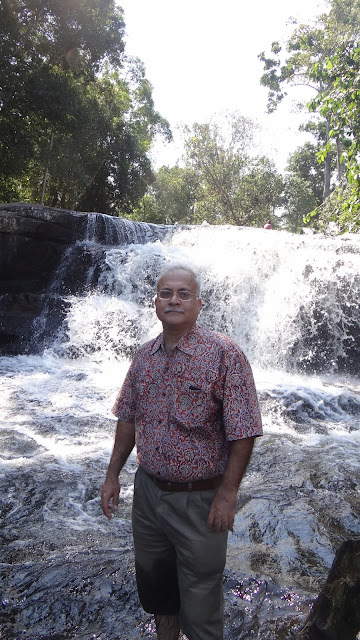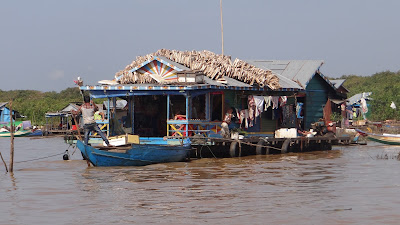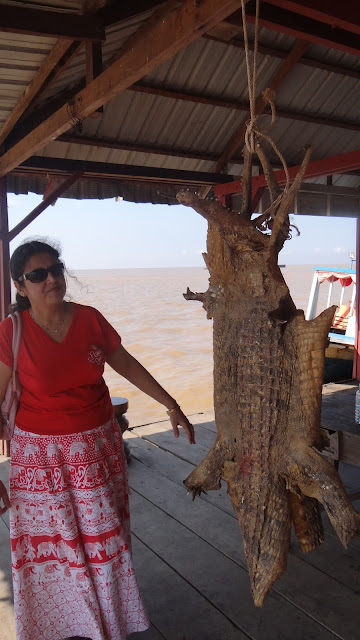The Ruins of Angkor - 4 - Phnom Kulen to Tonle Sap
North of the ruins of Angkor Wat, that we have described in previous posts [1], [2], [3] is the relatively small mountain range, Phnom Kulen [ the "Mountain of Lychees"] that most visitors give a miss to because there are no ruins of any massive temple that the Angkor civilisation is famous for. But for the rulers of Cambodia, these mountains were very significant. Jayavarman II, the first powerful king and the de facto founder of the Angkor dynasty, announced his ascendancy to the throne and the assumption of the title, Chakravartin -- the Supreme Ruler as per Indian / Hindu traditions -- from the top of this mountain in the 8th century and even the communist Pol Pot regime, that virtually destroyed the country in the closing years of the 20th century held on to these mountains as their last redoubt before they were ejected by the invading Vietnamese army.
Why are the Kulen Mountains so important ?
If you go back to the early years of the first millennium, yes, somewhere between the first and the seventh century CE, we see a trickle and then a flood of Hindu travellers, traders, adventurers, exiles, coming together to create an Indian state first in Funan and then in Angkor. It is possible that these people were from the Kamboj clan, mentioned in the Mahabharata as living around Gandhar, and hence the current name of the country, Kambodge, Kampuchea, Cambodia. The other possibility is that they were from the Chola kingdom from South India who too, had a tradition of making long sea voyages into South East Asia. It is most likely that they were a mixture of both.
Whatever be the case, being Hindus, what they all missed was the proximity to the Ganga and the purificatory benefits of ablution in its holy waters.
So the Kings of Angkor decided and decreed that what is now known as the Siem Reap river, that rises in the Kulen mountains and flows in the huge and ocean like Tonle Sap lake will henceforth be known as the Ganga of Kambodge! and its headwaters in the Kulen Moutain will be their very own Gangotri!
But how to give the sanctity of the Ganga to an unknown river in a far off land? They located the fountainhead, to the natural springs from where the river flows out and all along the river bed they carved a thousand, yes nearly one thousand, ShivaLingas. So now their very own Ganga was flowing out Shiva's Locks and they had their very own Holy river.
Here are some pictures of the Thousand Lingas, -- the Sahashra Lingas. Do remember that the river has been flowing over these Linga for more than a thousand years and hence they have been eroded but nevertheless they are clearly visible as a labour of love and a love for the Divine.
Why are the Kulen Mountains so important ?
If you go back to the early years of the first millennium, yes, somewhere between the first and the seventh century CE, we see a trickle and then a flood of Hindu travellers, traders, adventurers, exiles, coming together to create an Indian state first in Funan and then in Angkor. It is possible that these people were from the Kamboj clan, mentioned in the Mahabharata as living around Gandhar, and hence the current name of the country, Kambodge, Kampuchea, Cambodia. The other possibility is that they were from the Chola kingdom from South India who too, had a tradition of making long sea voyages into South East Asia. It is most likely that they were a mixture of both.
Whatever be the case, being Hindus, what they all missed was the proximity to the Ganga and the purificatory benefits of ablution in its holy waters.
So the Kings of Angkor decided and decreed that what is now known as the Siem Reap river, that rises in the Kulen mountains and flows in the huge and ocean like Tonle Sap lake will henceforth be known as the Ganga of Kambodge! and its headwaters in the Kulen Moutain will be their very own Gangotri!
But how to give the sanctity of the Ganga to an unknown river in a far off land? They located the fountainhead, to the natural springs from where the river flows out and all along the river bed they carved a thousand, yes nearly one thousand, ShivaLingas. So now their very own Ganga was flowing out Shiva's Locks and they had their very own Holy river.
Here are some pictures of the Thousand Lingas, -- the Sahashra Lingas. Do remember that the river has been flowing over these Linga for more than a thousand years and hence they have been eroded but nevertheless they are clearly visible as a labour of love and a love for the Divine.
in this picture, there is an image of Vishnu, but not very clear. The Shiva Lingas, come next
a big one
we passed through some shady glens through which a tributary of the Siem Reap flows
and finally we get a clear view of the hundreds of Shivalingas
Shiva Lingas in the background
here they are very clearly visible
And this a picture of one of the many natural springs from where the Siem Reap river gets its waters. Unfortunately, there are no Himalayas and its snow capped peaks
Getting into the water and walking over the Shiva Lingas is obviously forbidden.
However a little downstream there are three small waterfalls where people can have a bath in the sacred waters.
some more Vishnu images on the river bed, cordoned off
the first falls
After travelling through the Land of the Angkors, the river finally empties itself into the gigantic Tonle Sap, the largest fresh water lake in South East Asia. This lake has floating villages where people live their lives out on houseboats that actually move around.
the lake is huge and indeed looks like the sea
and with alligator farms and mangrove trees reminded me of the the Sunderbans
If there was a Kapil Muni Ashram as at Ganga Sagar, the picture would have been complete!













































Comments